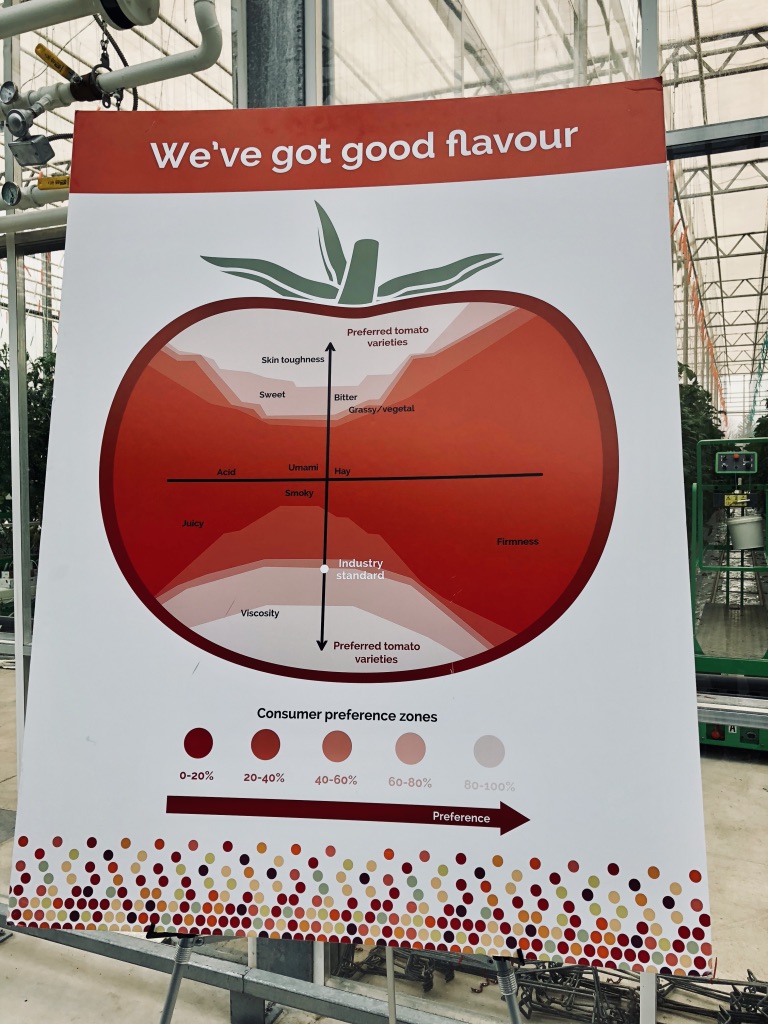
News
Growing the perfect Ontario tomato
May 18, 2018 By Greta Chiu
 Guests mingle at the Vineland Research and Innovation Centre Greenhouse Canada
Guests mingle at the Vineland Research and Innovation Centre Greenhouse CanadaVineland Research and Innovation Centre opened the doors to its award-winning greenhouse technology centre this week, sharing a glimpse of their research on one of Ontario’s most prominent greenhouse crops: the tomato.
For years, their goal has been to produce a greenhouse tomato that tastes as good as it yields. As one of the tour participants pointed out, field- and backyard-grown tomatoes are typically more flavourful. That’s the goal, says biochemist and researcher David Liscombe. But getting there is no easy task.
“Tomato flavour is super complex”, says Liscombe. The tomato contains over 400 different chemicals where 40 are volatile and released when chewed. It’s a combination of those compounds that ultimately make up the “taste” of the tomato. In comparison, the taste of banana really comes down to one main compound, and that’s easily distinguishable.
Acidity, sweetness, juiciness, texture – they’re all important, but Liscombe says texture ultimately seems to come first. If the texture is off-putting, then no other attribute seems to matter. To understand what makes different varieties taste distinctive and how they affect consumer preferences, a trained sensory panel came up with 20 terms to describe 56 chosen varieties.
The average consumer can say what tastes good and what doesn’t, says Amy Bowen, research director of consumer insights at the research centre. But when it comes to describing why, they have a harder time. By asking consumers which varieties they liked, or didn’t like, the research group was able to match those same varieties with the 20 characteristics established by the sensory panel and see where they differed.
In general, there were two main profiles that were liked by 80 to 100% of consumers – one that had thicker skin and more sweetness, another that had more viscosity around the seed. How does the current greenhouse tomato-on-the-vine (TOV) fare? Studies show that 60% of consumers like it. That’s not bad, but how can we do better? 
By understanding what makes particular varieties more appealing to consumers, explains Liscombe, these characteristics can be related back to the chemicals responsible for them, then back to the genes responsible for creating those chemicals.
“Breeding is about crop improvement,” says Valerio Primomo, research scientist of vegetable breeding. But there are many traits to juggle. For TOVs, the consumer wants better quality and more flavour, but the grower is looking for other qualities too – good yields, flat and compact clusters, disease resistance and good shelf life, for instance.
Primomo briefly outlines the process. The first step is to develop inbreds (self-pollinated) of about 70 different parents, then continuously collect and measure different parameters such as yield, disease level and fruit quality. Based on the results, 10 parents are chosen and cross-pollinated to create about 90 offspring, each with a different combination of genes.
Growers found that tomato varieties brought back from Holland just didn’t grow optimally, says Niki Bennett, science coordinator at Ontario Greenhouse Vegetable Growers (OGVG). Ontario has less sunlight, hot and sticky summers and intense winters compared to Holland.
Marketing, supporting research and lobbying on behalf of greenhouse vegetable growers in Ontario, the OGVG has partnered with Vineland to help bring this new tomato to their members. We’re developing a tomato for growers’ needs and consumers’ tastes in Ontario, stresses Justine Taylor, science & government relations manager at OGVG. Five to six varieties that emerge from this research will be trialed in commercial greenhouse operations, and hopefully be ready by 2021 or 2022.
As bioinformatics researcher Travis Banks points out, a grower’s production practices can affect the outcome. In a breeding program, they can use DNA markers to predict what a plant will look like. Breeders can use them to remove traits they don’t want and keeping the ones they do want, such as disease resistance. In the end though, differences in temperature, shading and other factors in the greenhouse environment can lead to different results, underscoring the importance of bringing the research from the lab and into growers’ greenhouses.
For more on the ongoing tomato research project, visit vinelandresearch.com
Did you know?
Completed in 2015, the collaborative greenhouse technology centre at Vineland Station was a winner of the 2018 Ontario Association of Architects Award. 20 winning projects were chosen among more than 111 submissions based on different criteria such as creativity, design, context, sustainability and legacy.
Source: http://www.oaa.on.ca/bloaag-detail/Collaborative-Greenhouse-Technology-Centre,-Vineland-Research-and-Innovation-Centre/482
Print this page
